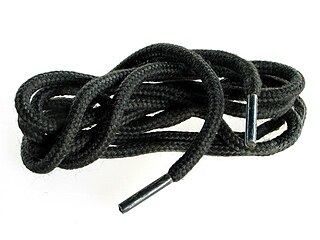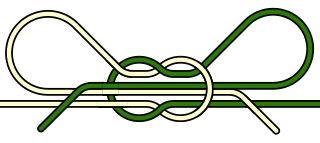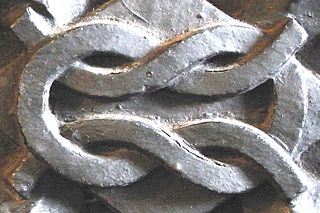
The overhand knot is one of the most fundamental knots, and it forms the basis of many others, including the simple noose, overhand loop, angler's loop, reef knot, fisherman's knot, half hitch, and water knot. The overhand knot is a stopper, especially when used alone, and hence it is very secure, to the point of jamming badly. It should be used if the knot is intended to be permanent. It is often used to prevent the end of a rope from unraveling. An overhand knot becomes a trefoil knot, a true knot in the mathematical sense, by joining the ends. It can also be adjusted, faired, or mis-tied as a half hitch.

A miller's knot is a binding knot used to secure the opening of a sack or bag. Historically, large sacks often contained grains; thus the association of these knots with the miller's trade. Several knots are known interchangeably by these three names.

The constrictor knot is one of the most effective binding knots. Simple and secure, it is a harsh knot that can be difficult or impossible to untie once tightened. It is made similarly to a clove hitch but with one end passed under the other, forming an overhand knot under a riding turn. The double constrictor knot is an even more robust variation that features two riding turns.

The clove hitch is an ancient type of knot, made of two successive single hitches tied around an object. It is most effectively used to secure a middle section of rope to an object it crosses over, such as a line on a fencepost. It can also be used as an ordinary hitch, or as a binding knot, but it is not particularly secure in either application. It is considered one of the most important knots, alongside the bowline and the sheet bend.
Although the name clove hitch is given by Falconer in his Dictionary of 1769, the knot is much older, having been tied in ratlines at least as early as the first quarter of the sixteenth century. This is shown in early sculpture and paintings. A round turn is taken with the ratline and then a hitch is added below. The forward end is always the first to be made fast.

The thief knot resembles the reef knot except that the free, or bitter ends are on opposite sides. It is said that sailors would secure their belongings in a ditty bag using the thief knot, often with the ends hidden. If another sailor went through the bag, the odds were high the thief would tie the bag back using the more common reef knot, revealing the tampering, hence the name. It is difficult to tie by mistake, unlike the granny knot, unless one attempts to tie a square knot in a similar manner to a sheet bend, then it is possible to tie accidentally.

A bend is a type of knot used to join two lengths of rope. Bends are used in a variety of situations, including climbing, sailing, and securing loads. They are classified based on their ability to be tightened or released, their resistance to slipping, and their strength. Some common types include the sheet bend, the double fisherman's knot, and the double figure-eight bend. Bends allow two ropes to be securely joined together, enabling the combined ropes to support weight or transmit force. It is important to choose the appropriate bend for the specific task at hand, as some may be stronger or more secure than others.
A whipping knot or whipping is a binding of marline twine or whipcord around the end of a rope to prevent its natural tendency to fray.

A grief knot is a knot which combines the features of a granny knot and a thief knot, producing a result which is not generally useful for working purposes. The word grief does not carry its usual meaning but is a portmanteau of granny and thief.

Shoelaces, also called shoestrings or bootlaces, are a system commonly used to secure shoes, boots, and other footwear. They typically consist of a pair of strings or cords, one for each shoe, finished off at both ends with stiff sections, known as aglets. Each shoelace typically passes through a series of holes, eyelets, loops or hooks on either side of the shoe. Loosening the lacing allows the shoe to open wide enough for the foot to be inserted or removed. Tightening the lacing and tying off the ends secures the foot firmly within the shoe. The laces can be tied in different shapes, most commonly a simple bow.

The sheet bend is a bend knot. It is practical for joining lines of different diameter or rigidity. Becket Hitch: The Becket Hitch is a very similar knot. However, it is a “Hitch”: it does not join two ropes, it attaches a rope to a Becket. In the animation the Blue Rope would be Becket and the Red Rope would be tied to it with a Becket Hitch.

The surgeon's knot is a surgical knot and is a simple modification to the reef knot. It adds an extra twist when tying the first throw, forming a double overhand knot. The additional turn provides more friction and can reduce loosening while the second half of the knot is tied. This knot is commonly used by surgeons in situations where it is important to maintain tension on a suture, giving it its name.

The shoelace knot, or bow knot, is commonly used for tying shoelaces and bow ties.

The basket weave knots are a family of bend and lanyard knots with a regular pattern of over–one, under–one. All of these knots are rectangular and lie in a plane. They are named after plait-woven baskets, which have a similar appearance.

The reef knot, or square knot, is an ancient and simple binding knot used to secure a rope or line around an object. It is sometimes also referred to as a Hercules knot. The knot is formed by tying a left-handed overhand knot between two ends, instead of around one end, and then a right-handed overhand knot via the same procedure, or vice versa. A common mnemonic for this procedure is "right over left; left over right", which is often appended with the rhyming suffix "... makes a knot both tidy and tight". Two consecutive overhands tied as described above of the same handedness will make a granny knot. The working ends of the reef knot must emerge both at the top or both at the bottom, otherwise a thief knot results.
The reef knot or square knot consists of two half knots, one left and one right, one being tied on top of the other, and either being tied first...The reef knot is unique in that it may be tied and tightened with both ends. It is universally used for parcels, rolls and bundles. At sea it is always employed in reefing and furling sails and stopping clothes for drying. But under no circumstances should it ever be tied as a bend, for if tied with two ends of unequal size, or if one end is stiffer or smoother than the other, the knot is almost bound to spill. Except for its true purpose of binding it is a knot to be shunned.

The Bourchier knot is a variety of heraldic knot. It was used as a heraldic badge by the Bourchier family, whose earliest prominent ancestor in England was John de Bourchier, a Judge of the Common Pleas, seated at Stanstead Hall in the parish of Halstead, Essex. He was the father of Robert Bourchier, 1st Baron Bourchier (d.1349), Lord Chancellor of England. The various branches of his descendants held the titles Baron Bourchier, Count of Eu, Viscount Bourchier, Earl of Essex, Baron Berners, Baron FitzWarin and Earl of Bath. The knot should perhaps have been called the "FitzWarin knot" as according to Boutell (1864) the device was first used by the FitzWarin family, whose heir was the Bourchier family.

The Chinese button knot is essentially a knife lanyard knot where the lanyard loop is shortened to a minimum, i.e. tightened to the knot itself. There emerges therefore only two lines next to each other from the knot: the beginning and the end. The knot has traditionally been used as a button on clothes in Asia, thus the name.
The Chinese Button Knot is worn throughout China on underwear and night clothes. Buttons of this sort are more comfortable to lie on and to rest against compared to common bone and composition buttons, and they cannot be broken even by the laundry.
A Chinese tailor ties the knot without guide, flat on his table. But one may be more quickly and easily tied in hand by a modification of the sailor’s method of tying his knife lanyard knot (#787). The two knots are tied alike, but they are worked differently.

The Lapp knot is a type of bend. It has the same structure as the sheet bend, but the opposite ends are loaded. The slipped Lapp bend is also an exploding knot, which means that when pulling the quick release end it falls completely apart without further entanglement. It is as strong as or even stronger than the sheet bend, though much less common.





















